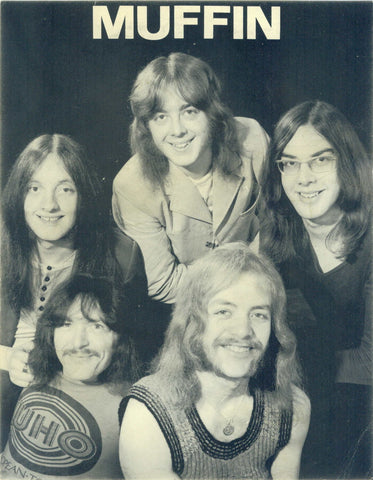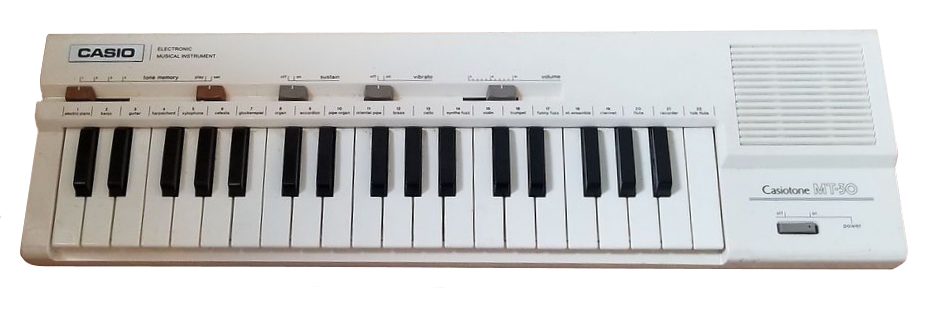Rob Hubbard... in the beginning!
Fancy a Muffin? In the long lost days of the 1970s, Rob Hubbard was part of a group named after this calorific baked treat as their keyboard player, and continued playing in bands right up until he left the UK in 1988 (mostly in covers bands).

Muffin was more of a lifestyle than a band, though: they went on tours (including one to Norway that went down really well) and gigged constantly, sometimes doing two shows a night. That kind of lifestyle can be exhausting. Rob’s escape to balance was technology as he leveraged his musical connections to get access to studios and began to work on electronic music, both in the studio with later-Lindesfarne-member Steve Daggett (working on a rock opera called “Work is a 4-letter word”), and then at home on his four-track reel-to-reel tape recorder.

As well as somehow being able to get the money together to buy iconic synths such as the Roland TB-303 and gear such as the Korg Polysix and the Roland MC-202 sequencer, he would build electronic kit that was featured in magazines, such as a DIY drum machine, for which you would order the parts and of course build it yourself. And of course his precious Casio MT30 on which he'd jot his most important ideas:

When his favourite magazine E&MM (“Electronics & Music Magazine”) started to feature reviews of microcomputers Rob felt very strongly that it would be very cool indeed to find out more. He started buying weekly and monthly computer magazines to decide how to get started.
It wasn’t until the Commodore 64 (with its huge memory and sound chip) was reduced in price in August/September 1983 that Rob bought one (in November, in fact - hey, he had to save up you know!).
That price reduction also launched the torrent of C64 software that arrived in 1984: despite its launch at the end of 1982, C64 software was very thin on the ground in 1983 with releases coming mostly from:
- Llamasoft (flush with cash from the success of Gridrunner in the United States)
- The Llamasoft spinoff/nemesis Interceptor Micros (flush with cash from the success of Llamasoft)
- Anirog (a computer store that was also a software house, with easy access to technology)
- Audiogenic (who had been in software since 1981 and had made a bob or two!)
- Rabbit Software for some reason
- Mr Chip (who had found a genius in David Whittaker and then wasted him)
- Terminal Software (who inherited David when Mr Chip pissed him off)
- … and Commodore themselves.
In fact, in summer 1983, there were more games for the Dragon 32, Atari 400/800, BBC, ZX81, Vic 20 and ZX Spectrum than there were for the C64.
So, flush with new technology and reading reviews of music education software in E&MM that didn’t look very good, Rob started to develop his own better software. And of course, it was better - but it was for the wrong platform, given the BBC Micro’s commanding market share in the education sector and the limited budgets available to music departments, plus a lack of marketing vision that will be familiar to anyone trying to do a startup:
"At the time, E&MM was showing all this highfaluting educational software that was coming out of America for the Apple, and machines like it. I thought I could write something like that for the 64, and be the first in this country to do it. So I wrote this piece of educational music software, all notes on a stave, 'find the mistake", and that sort of thing. But with Britain being ten years behind the States, not in its brains but in its attitudes, I couldn't find anyone who was interested in marketing it."- Rob Hubbard
Towards the tail end of that experience Rob, frustrated with the slow speed of Microsoft BASIC started to learn machine code, and soon had the tools to start pitching for related work in April 1984.
After his first music job (a number of simple tune conversions for the C64 version of Starcade’s “Up Up and Away”), he landed a contract with local game studio “Ubik”, who set him to work on a sequel for their forthcoming Weetabix-based game eventually released as “Paranoid Pete”. Working like a demon over the Summer, he finished the game only to see Ubik collapse because they thought they had a licence from Weetabix when they only had an expression of polite interest.

Whoops! Attempts to change the main character in Rob’s game from a Weetabix guy to a strawberry and attach another licence (for the regional pop music show “Razzmatazz”, which starred a very young Lisa Stansfield) were kind of pointless.
Although he owned the game, it was now based on a license he didn’t have and contained music he didn’t own. He was advised by friends that the game wasn’t very good anyway, but those friends did like the music. Despite previously having done the “Up Up and Away” gig as a one-off, it hadn’t occurred to him that such a job could exist - and he already knew that most music and sound in games was pretty poor. So in October 1984 Rob decided to do a mailshot of computer game companies (along with a lot of phone calls) to market himself as the answer to their musical prayers at low low princess.
In common with many creative geniuses, self-marketing was difficult: what do you say apart from “Looking for a great musician? Call Rob!”? And in fact, that’s what the leaflet said. Despite self-marketing being a depressing experience for any creative, Rob’s work ethic and need to actually earn money drove him on, but the lack of response to the leaflet by the end of the year left him profoundly dispirited.
His love for computing and computers was undiminished though. This, combined with encouragement to try again from his girlfriend (now wife), gave him the energy to add new music to the demo. Not only that, but right at the end, in order to do Mozart’s “Rondo alla Turca” justice, he rewrote his driver entirely to be better in every way, and thus defined the unique sound that was behind every game from Confuzion to Hollywood or Bust.

There’s an irony here. Rob’s career was made by “Thing on a Spring” and “Monty on the Run”, both from Micro Projects. But Micro Projects’ Jason Perkins had never heard his cassette: they just came across his leaflet months after he’d given up at exactly the time they needed a musician. If Rob hadn’t rewritten his driver in response to his perceived failure, he would have been unprepared for success. So perhaps even perceived failure has a use!
Find out much more about Rob’s games and history in the official illustrated 350-page softography “Master of Magic”, available from Fusion Retro Books and C64Audio.com for a limited time as a first-edition hardback.
Master of Magic - Official Rob Hubbard Softography
Hubbard Book Blog
Rob Hubbard - All Products
